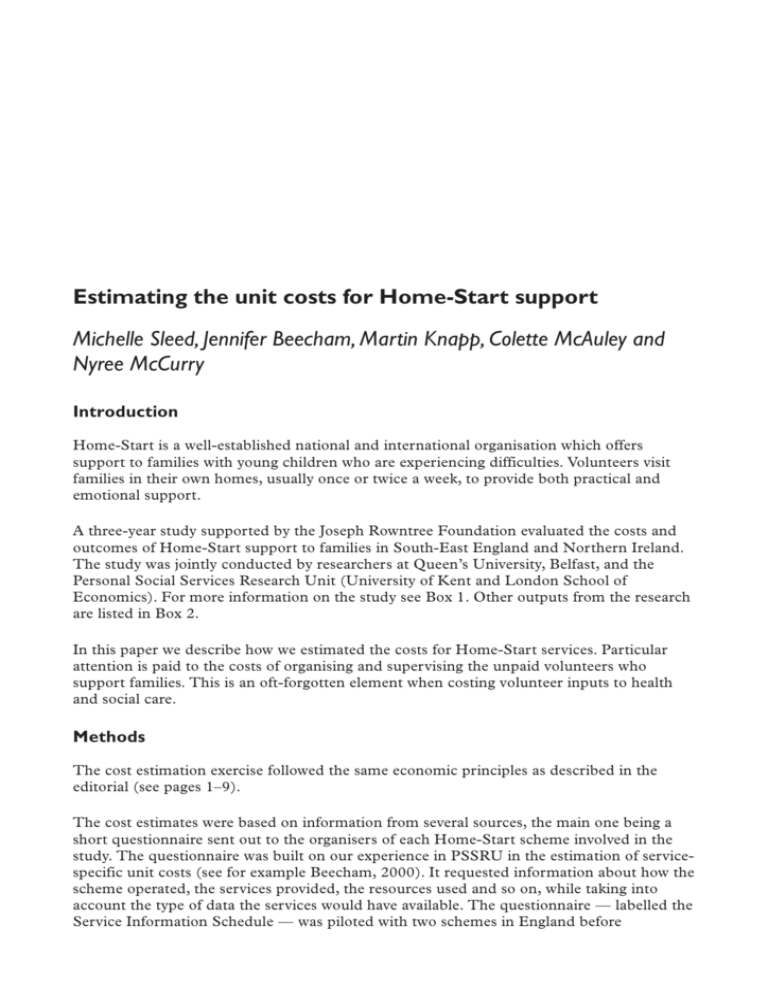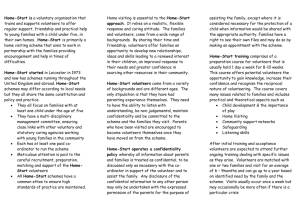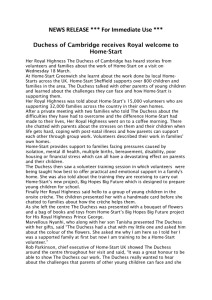Estimating the unit costs for Home-Start support
advertisement

Estimating the unit costs for Home-Start support Michelle Sleed, Jennifer Beecham, Martin Knapp, Colette McAuley and Nyree McCurry Introduction Home-Start is a well-established national and international organisation which offers support to families with young children who are experiencing difficulties. Volunteers visit families in their own homes, usually once or twice a week, to provide both practical and emotional support. A three-year study supported by the Joseph Rowntree Foundation evaluated the costs and outcomes of Home-Start support to families in South-East England and Northern Ireland. The study was jointly conducted by researchers at Queen’s University, Belfast, and the Personal Social Services Research Unit (University of Kent and London School of Economics). For more information on the study see Box 1. Other outputs from the research are listed in Box 2. In this paper we describe how we estimated the costs for Home-Start services. Particular attention is paid to the costs of organising and supervising the unpaid volunteers who support families. This is an oft-forgotten element when costing volunteer inputs to health and social care. Methods The cost estimation exercise followed the same economic principles as described in the editorial (see pages 1–9). The cost estimates were based on information from several sources, the main one being a short questionnaire sent out to the organisers of each Home-Start scheme involved in the study. The questionnaire was built on our experience in PSSRU in the estimation of servicespecific unit costs (see for example Beecham, 2000). It requested information about how the scheme operated, the services provided, the resources used and so on, while taking into account the type of data the services would have available. The questionnaire — labelled the Service Information Schedule — was piloted with two schemes in England before 26 Unit Costs of Health and Social Care 2004 Box 1: The Home-Start Evaluation The aim of this Rowntree-supported study was to evaluate the outcomes and costs of Home-Start support to young families in the community who were experiencing stress. A quasi-experimental design was employed, comparing two groups of families in receipt of Home-Start support — one group in South-East England and the other in Northern Ireland — with families living in two areas where Home-Start was not operating — again one group each in South-East England and Northern Ireland. In total, 162 families were assessed over one year. It was noticeable that most mothers interviewed had high levels of need and were experiencing a lot of parenting stress. Some also reported depressive symptoms. Their children often had problems with emotional and social development. Home-Start volunteers provided home visiting support to 80 families, averaging 2½ hours per family per week for about 9 months. The volunteers offered emotional support, practical assistance and help with outings. circulation. Each Home-Start scheme was also asked to provide their 2001-2002 expenditure accounts and annual reports. Further information was provided in the Volunteer Activity Forms, completed at up to three time points by each volunteer supporting a participating family (one month, six months and 12 months after starting to visit the family, or for the last month of support if it ended within a year). These forms, completed by the volunteers for a retrospective period of one month, provided data on the number and duration of visits and travelling time to the family, and allowed costs to reflect the specific intensity with which each family received the service. A consistent methodology was employed across all schemes to ensure that all costs were included for each scheme, and that each element of costs was treated in the same manner. To ensure capital costs were correctly and consistently calculated we replaced information appearing in the accounts as rents, capital charges and the like with standardised estimates. These were based on the new build and land requirements for a local authority office and shared facilities (BCIS, 2001; DETR, 2000). The convention for calculating the opportunity costs of capital is to assume that the best alternative would be to invest the resources to earn interest over the life span of the building. Based on this premise, the capital costs were annuitised at a rate of 6 per cent over 60 years and adjusted for regional price differences (South East England and Northern Ireland) using appropriate pricing adjustment factors (BCIS, 2001). The expenditure accounts and information about each scheme allowed us to estimate the short-run revenue costs and included the following elements. • paid staff costs (salaries, national insurance contributions, pensions, travel and training). • running costs (for example lights, stationery, telephone and affiliation fees). • volunteer related expenses such as travel and training. • client related expenses such as provision of other activities. A number of adjustments had to be made to the information provided by the Home-Start providers. For example, often the local Home-Start services provided other support services as well as home visiting. Costs for these other activities, such as family groups, were excluded by deducting an estimate of paid staff time spent on these activities from total Unit Costs of Health and Social Care 2004 27 Box 2: Outputs from the Study Colette McAuley, Martin Knapp, Jennifer Beecham, Nyree McCurry and Michelle Sleed (2004) Evaluating the Outcomes and Costs of Home-Start Support to Young Families Experiencing Stress: A Comparative Cross-Nation Study, Joseph Rowntree Foundation, York, forthcoming. A number of papers in peer-reviewed journals are planned for this project covering aspects of service use, costs and cost-effectiveness as well as the findings from the quantitative and qualitative outcomes analyses. costs. Similarly, where the expenditure accounts gave the costs of rent and other building services (light, heat, maintenance) together, in order to include the latter costs but exclude the former, an estimate was made based on the average for those schemes where these costs were given separately. Over and above the volunteer visitors, there were also a number of other people who spent unpaid time supporting the Home-Start schemes. Every scheme had a management committee, on average involving 12 people. Information about time spent on Home-Startrelated activities by the committees was available for only a couple of the schemes, giving an average of about 600 hours per year. However, too little information was available for this estimate to be generalisable to all schemes, and so no costs were included for this nevertheless important input. It is worth noting that these costs could be considerable; they are usually carried by the agencies that employ the management group members, including the statutory local health or social services organisations. There are no other organisational overheads occurring for these schemes, for each local Home-Start service stands alone rather than as part of a wider organisation. Each local services is affiliated to the national Home-Start organisation and the fee payable has been included as part of the revenue costs. Organisational costs of running a Home-Start scheme Adding together the revenue and capital costs for running each scheme gives the total cost for the year. In the research our interest was in the cost per visit to a family. Other information from the questionnaire completed by the organisers, such as number of families supported, number of volunteers and average number and duration of visits to families, enabled us to work out a range of average unit costs for each Home-Start scheme. These are presented in table 1 for the Home-Start schemes in England and Northern Ireland. Table 1 Breakdown of 2001–2002 organisational costs for Home-Start schemes Cost measures England Northern Ireland Total Total cost for year (£): Mean (range) £88,850 (£47,640–£134,230) £41,440 (£21,290-£58,210) £55,660 (£21,290-£134,230) Cost per active volunteer (£): Mean (range) £2,580 (£1,700-£4,330) £2,100 (£1,420-£2,960) £2,240 (£1,420-£4,330) Cost per family supported over year (£): Mean (range) £706 (£550-£920) £1,120 (£674-£2,040) £1,000 (£550-£2,040) Cost per home visit (£): Mean (range) £14 (£11-£18) £25 (£13-£39) £22 (£11-£39) 28 Unit Costs of Health and Social Care 2004 The costs of volunteer visitors Of course, the costs presented above are those associated with organising Home-Start volunteer visiting and do not include the costs of the volunteers. In estimating the full opportunity costs of Home-Start all unpaid time spent on service-related activities need to be taken into account (see for example Knapp, 1984; Netten, 1993). The volunteers gave a large amount of unpaid time to the families and each volunteer recorded details of the time spent with each family. In table 1 these, by definition, are set as zero. Conclusion The calculations in table 1 use data from 19 Home-Start organisations in Northern Ireland and South East England. Ideally, we would prefer a larger sample and greater coverage across the UK. However, the schemes we worked with operated in both rural and urban areas and varied widely in terms of the number of volunteers managed and families served. This variety and the consistency of the methodology employed ensures that at the least the units are representative of organisations in these two areas but also are likely to have national relevance. References Beecham, J. (2000) Unit Costs — Not Exactly Child’s Play. A Guide to Estimating Unit Costs for Children's Social Care, Joint publication from the Department of Health, Dartington Social Research Unit and the Personal Social Services Research Unit, University of Kent, Canterbury. See also www.pssru.ac.uk/ publications.htm. Building Cost Information Service (2001) Surveys of Tender Prices, February, BCIS, Royal Institution of Chartered Surveyors, London. Department of the Environment, Transport and the Regions (2000) Housing and Construction Statistics 1988–98, The Stationery Office, London. The appropriate inflator is provided by the DETR on request. Knapp, M. (1984) The Economics of Social Care, Macmillan, London. Netten, A. (1993) Costing informal care, in A. Netten & J. Beecham (eds) Costing Community Care: Theory and Practice, Ashgate, Aldershot. Netten, A. & Curtis, L. (2001) Unit Costs of Health and Social Care 2001, Personal Social Services Research Unit, University of Kent, Canterbury.







